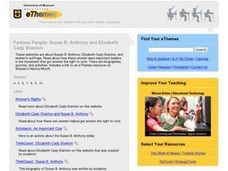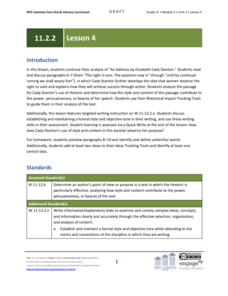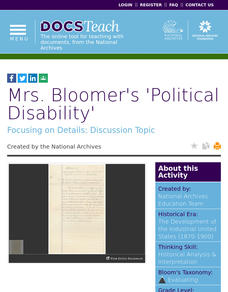Curated OER
Cartoons for the Classroom: Celebrating the 19th Amendment
Eighty-eight years after women earned the right to vote, a women ran for president. Young analysts consider the role women play in politics, how they are portrayed, the standards they are held to, and if they are still treated unfairly...
Curated OER
Ballots, Bloomers and Boycotts
Students compare a controversial issue or policy in need of reform in their classroom to the suffrage movement of the 1800's. They research important figures in the suffrage movement, produce written pieces and complete worksheets.
Curated OER
Writing Exercise: Economic and Social Revolution I
Learners take a critical look at the economic and social changes that stemmed from the industrial revolution. There are three short essay questions for them to answer regarding suffrage, changes in women's rights, and urbanization as a...
Curated OER
The Wyandotte Constitutional Convention: The Issue of Suffrage
Seventh graders discover details about the Wyandotte Constitutional Convention. In this Kansas history activity, 7th graders tackle civil rights concerns as they draft persuasive speeches to secure the rights of young voters in the state.
Curated OER
Women Get the Vote!
Students research the history of United States voting rights to describe and analyze why voting rights and responsibilities are important. They investigate famous suffragists like Susan B. Anthony and then create a "wanted" poster and...
Curated OER
FAMOUS PEOPLE: SUSAN B. ANTHONY AND ELIZABETH CADY STANTON
Students explore websites are about Susan B. Anthony, Elizabeth Cady Stanton, and women's suffrage and read about how these women were important leaders in the movement that got women the right to vote.
Curated OER
Suffragettes
Students investigate peer pressure by discussing women's suffrage. In this Women's rights lesson, students explore the history of voting in the United States and when women were finally allowed to do so. Students create a poster in order...
Polk County Public Schools
Suffragists
The Women's Rights movement is the focus of an engaging and collaborative exercise, in which young historians use information found in textbooks, class notes, and the provided documents to craft a DBQ essay.
Education World
Every Day Edit - Women Get the Vote
In this everyday editing worksheet, students correct grammatical mistakes in a short paragraph about suffrage. The errors range from punctuation, capitalization, grammar, and spelling.
Bill of Rights Institute
Freedom for All?
What did abolitionists have in common with those working for women's rights? How has the Native American struggle for voting rights differed from the struggles of other groups? Class members examine the 15th, 19th, 23rd, 24th, and 26th...
Facing History and Ourselves
The Audacity of a Vote: Susan B. Anthony’s Arrest
Susan B. Anthony's speech "Is It a Crime for Women to Vote?" takes center stage in a lesson that asks class members to consider how they might respond to what they consider an unjust law. Groups work through the speech paragraph by...
National Woman's History Museum
Martha Hughes Cannon: Doctor, Wife, Mother, Senator
Each state is entitled to two statues in the National Statuary Hall Collection in Washington, D.C. After reading about Utah's debate over whether or not Martha Hughes Cannon should be represented by one of their statues, individuals...
EngageNY
Grade 11 ELA Module 2: Unit 2, Lesson 4
How does style contribute to the power and persuasiveness of a speech? With the question in mind, scholars continue reading "An Address by Elizabeth Cady Stanton." They complete a Rhetorical Impact Tracking Tool to guide them in their...
Scholastic
The Right to Vote
Who used to have the right to vote in the United States? Who has the right to vote now? Amendments to the US Constitution that have changed the definition of eligible voters are the focus of a one-page activity that asks class members to...
US House of Representatives
Objects in Time
What is the role artifacts play in the study of past events and people? As part of an examination of the careers and contributions of women in Congress from 1917 to 2006, groups examine artifacts that symbolize each woman.
Stanford University
Anti-Suffragists
Students view the movie Iron Jawed Suffragists.In this anti- suffragists instructional activity, students recognize that many people didn't want women's suffrage. Students view documents written about suffrage and create a graphic...
Library of Congress
Suffragists and Their Tactics
Students research the fight for voting rights. In this women's history lesson, students analyze primary sources to develop an understanding of the strategies employed by the suffragists to gain voting rights.
Curated OER
Susan B. Anthony and the 19th Amendment
Students take a closer look at the Women's Suffrage Movement in America. In this women's rights lesson, students research suffrage leaders and write papers about them. Students then read and discuss information about Susan B. Anthony's...
Curated OER
Suffragettes Activities
In this suffragettes worksheet, students match the words about suffrage with their meanings. Students list 8 methods the suffragettes used and one peaceful method they could have used.
Smithsonian Institution
The Suffragist: Educator's Guide for Classroom Video
Class members take on the role of historical investigators to determine why it took 40 years for women in the United States to get the right to vote. Sleuths view videos and analyze primary sources and images to gather evidence to answer...
National Woman's History Museum
Seneca Falls Convention
The 1848 Seneca Falls Convention was a historic milestone in the quest for women's rights. After researching one of the participants of the Seneca Falls Convention, young historians craft and share a short presentation about their subject.
DocsTeach
Mrs. Bloomer's 'Political Disability'
It's hard to believe that women had to argue for the right to vote a mere 100 years ago. Today, young historians can examine their case left behind in primary sources. Using a letter from a woman who claimed she should be able to vote...
National Woman's History Museum
Songs of Protest: Seneca Falls to Vietnam
Long before the songs of the 1960's Peace Movement, long before the songs of the Civil Rights Movement, and even before the songs of the Abolition Movement, were the songs of the Suffrage Movement. To understand the power of protest...
National Woman's History Museum
The Power of Words and Activism: Susan B. Anthony
Where have all the activists gone? Class members compare 21st-century activism with the suffrage movement and the work of Susan B. Anthony. They begin by examining Anthony's biography and speeches to find evidence that her words and...

























